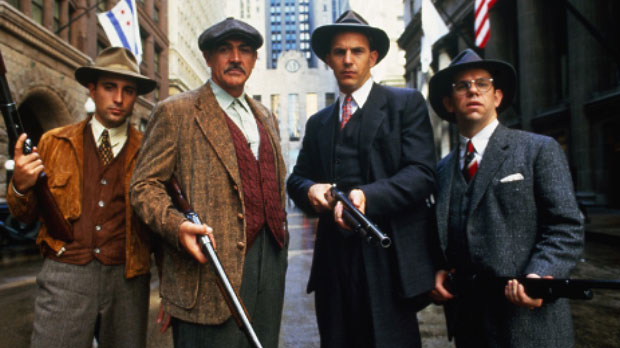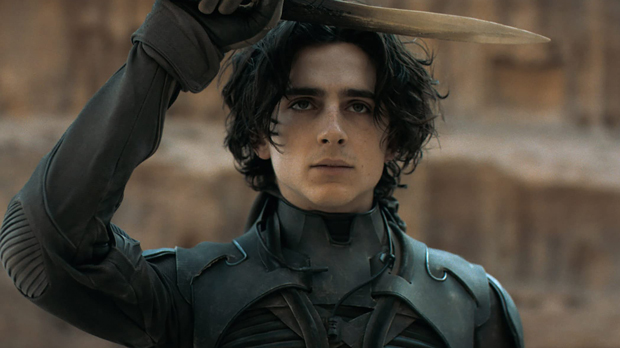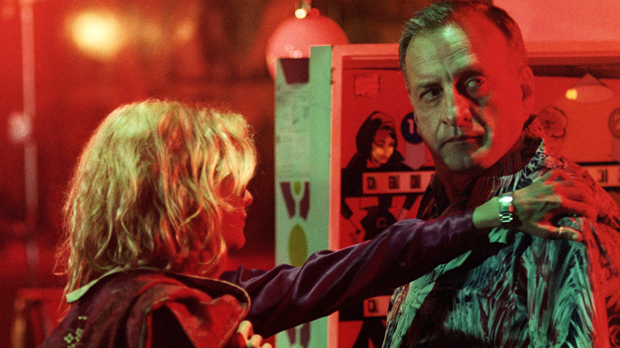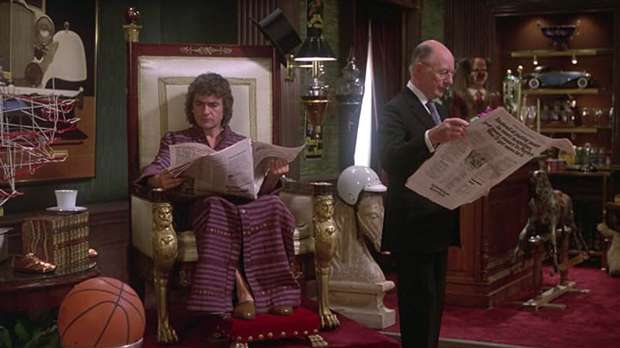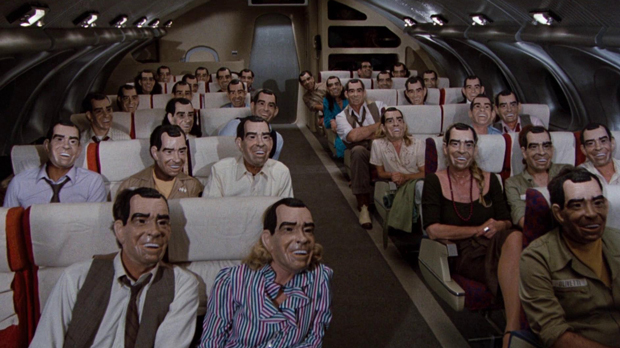 The Untouchables (1987) Paramount/Action-Drama RT: 119 minutes Rated R (strong bloody violence, language) Director: Brian De Palma Screenplay: David Mamet Music: Ennio Morricone Cinematography: Stephen H. Burum Release date: June 3, 1987 (US) Cast: Kevin Costner, Charles Martin Smith, Andy Garcia, Robert De Niro, Sean Connery, Richard Bradford, Jack Kehoe, Brad Sullivan, Billy Drago, Patricia Clarkson, Del Close, Vito D’Ambrosio, Steven Goldstein, Don Harvey, Robert Swan, Clifton James (uncredited). Box Office: $76.2M (US)/$106.2M (World)
The Untouchables (1987) Paramount/Action-Drama RT: 119 minutes Rated R (strong bloody violence, language) Director: Brian De Palma Screenplay: David Mamet Music: Ennio Morricone Cinematography: Stephen H. Burum Release date: June 3, 1987 (US) Cast: Kevin Costner, Charles Martin Smith, Andy Garcia, Robert De Niro, Sean Connery, Richard Bradford, Jack Kehoe, Brad Sullivan, Billy Drago, Patricia Clarkson, Del Close, Vito D’Ambrosio, Steven Goldstein, Don Harvey, Robert Swan, Clifton James (uncredited). Box Office: $76.2M (US)/$106.2M (World)
Rating: ****
Brian De Palma’s The Untouchables is the exception to the rule that popular TV shows don’t make good movies. Actually, there have been a few good ones, but this is the very best of them. It’s grand entertainment all the way through, from first frame to last.
The original series, which starred Robert Stack as US Treasury agent Eliot Ness, ran from 1959-63. It followed Ness and his team of incorruptible agents- aka “The Untouchables”- as they attempted to stem the flow of illegal booze into Chicago during Prohibition. Kevin Costner (No Way Out) takes over Stack’s role in the 1987 film. His Agent Ness is sent to Chicago to take down Al Capone (De Niro, Taxi Driver), a powerful mob boss who has nearly the entire city under his control. He’s the most feared crime figure of the time with his penchant for brutal violence. He thinks he’s untouchable, but he’s headed for a big downfall.
Ness’ first day on the job is marked by failure when a warehouse thought to contain a large quantity of Canadian whiskey comes up empty. Humiliated and wallowing in self-pity, he has a chance meeting with a tough Irish-American beat cop, Jimmy Malone (Connery, the original James Bond), who offers up a few words of wisdom before going on his way. He later agrees to join Ness in his crusade against Capone. It turns out he’s as fed up with crime and corruption as Ness. He’s one of the few honest cops on the force. It’s his idea to recruit a cadet from the academy, ace marksman George Stone (Garcia, The Godfather Part III), to join them. In his words, “If you’re afraid of getting a rotten apple, don’t go to the barrel. Get it off the tree.” The team is rounded out by Oscar Wallace (Smith, American Graffiti), a Treasury accountant who discovers they can get the original Teflon Don on income tax evasion. Together, the Untouchables wage war on Capone and his bootlegging operation.
I’m tempted to describe The Untouchables as a work of art. Everything about it is so artful. Even when the violence gets ugly, it’s still beautiful. It’s the combined work of several artists: visual consultant Patrizia von Brandenstein (Ragtime), cinematographer Stephen H. Burum (The Outsiders), costume designer Marilyn Vance-Straker (The Rocketeer), art director William A. Elliott (Silverado) and set decorator Hal Gausman (Mary Poppins). All of these components come together in complete visual harmony. The cherry on top is the wonderful score by Ennio Morricone (The Good, the Bad and the Ugly). It’s then served up by the sure-handed De Palma (Scarface) working from a tight script by David Mamet (Glengarry Glen Ross). Such a collection of behind-the-camera talent; such an incredible film. And I haven’t even gotten to the performances yet.
Connery, who won Best Supporting Actor for his part, is the real stand-out. He brings his character to full life even when he’s just talking. The scene where he explains “the Chicago way” of justice to Ness in a church is probably his character’s defining moment. Mamet’s dialogue sounds even greater when Connery says it- e.g. “They pull a knife, you pull a gun. He sends one of yours to the hospital, you send one of his to the morgue.” In his first starring role, Costner acquits himself nicely as Ness, a straight-arrow T-Man determined to get Capone by all legal means- i.e. “anything within the law”. Of course, that’s NOT how things work in Chicago. We get to see inside his personal life off the job. At home, he has a pregnant wife (Clarkson, The Dead Pool) and young daughter. There will come a point when the dangers of his job hit too close to home.
De Niro, who put on 30 lbs for the role, is perfect as Capone. Granted, his scenes seem detached from the rest of the movie, but he’s no less a looming presence for it. He gives us a clear idea of Capone’s propensity for sudden violence in scenes like the one in which he bashes an underling’s head in with a bat after delivering a monologue about baseball and teamwork. In smaller but no less important roles, Garcia and Smith are terrific. I’d also like to praise character actor Billy Drago (Invasion USA) as Capone’s chief enforcer Frank Nitti. This is the performance of his career. It’s also the one that first brought him to my attention. His climactic fight with Ness on the roof of the courthouse building is awesome.
I’d be remiss in my duties if I didn’t discuss a couple of key scenes in The Untouchables. In a movie of pure greatness, they stand out. The first is the joint American-Canadian operation to intercept a shipment of illegal booze at the border. One of Capone’s guys (Sullivan, Slap Shot) is taken alive, but refuses to talk. No problem. Malone steps outside the cabin and pretends to interrogate a dead gangster before shooting him in the face. The frightened fellow agrees to tell them everything he knows. Hey, whatever works. The other, the most iconic scene in the movie, is the shootout on the stairs at Union Station. As bullets fly, a baby carriage with a baby inside rolls down the steps directly in the line of fire. For those that don’t know, this scene is a homage to the 1926 Russian-made silent film Battleship Potemkin.
Not only is The Untouchables the best of the TV-to-film adaptations, it’s also one of De Palma’s best films. I’d even dare to say it’s one of the best gangster films of the latter 20th century. I’ll take it another step further and say it’s pure movie magic. It gets everything right even if it takes liberties with the story (it’s based on historical fact). So what, it makes for a great movie!
